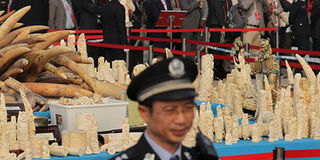Tusks have been in demand for centuries

A policeman stands in front of a pile of ivory before being crushed during a public event in Dongguan, south China's Guangdong province on January 6, 2014. China crushed a pile of ivory reportedly weighing over six tonnes on January 6, in a landmark event aimed at shedding its image as a global hub for the illegal trade in African elephant tusks. CHINA OUT | AFP PHOTO
What you need to know:
- Ivory has been in use from prehistoric times in ancient Egypt, China, India and Japan through to the empires of Greece and Rome, followed by medieval Europe, early African kingdoms and the Muslim world, to 19th century America, France’s Napoleonic empire and Victorian Britain.
- Ivory has also been important for the Christian faith, with figurines of crucifixions, the Madonna and Child, and various saints and plaques of biblical stories dating back as early as the 9th century in France.
Over the centuries, ivory has been used in the preservation of culture and heritage. It has been used in religion, art, decorations and as a utility — from 30,000-year old Venus figurines to 21st century pistol grips.
Ivory has been in use from prehistoric times in ancient Egypt, China, India and Japan through to the empires of Greece and Rome, followed by medieval Europe, early African kingdoms and the Muslim world, to 19th century America, France’s Napoleonic empire and Victorian Britain.
Described as a sensuous, smooth material in a report by Traffic — the wildlife trade monitoring network — ivory holds significant cultural importance in Hindu and Buddhist Asia.
The report states that according to religious practice Ganesha, the elephant-headed god, is worshipped from India to Singapore, and the celestial white elephant held the lotus flower that led to the reincarnation of the Lord Buddha.
“Its uniqueness in the length of the white tusks of the elephant have inherited some of the animal’s divinity, and ivory Ganesha and other religious figurines are common even today throughout South and South East Asia,” it reads.
BRING LUCK
It further says from Myanmar to Japan, Buddhist and Taoist figurines have long been important subjects of ivory carvings as they are considered to bring luck when displayed in the home. The oldest ivory Buddha figurines are known from the 13th century and the first ivory figurines of the Eight Immortals date from the 14th century.
Ivory has also been important for the Christian faith, with figurines of crucifixions, the Madonna and Child, and various saints and plaques of biblical stories dating back as early as the 9th century in France.
The report states that these same subjects are carved today in Europe, Africa and the Philippines. Islamic countries also have a very long history of using ivory, mainly as containers, inlay in furniture and ornamentation on weapons.





